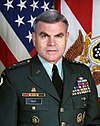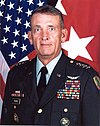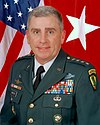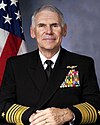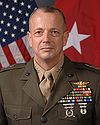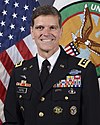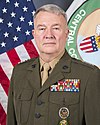United States Central Command
| United States Central Command (CENTCOM) | |
|---|---|
| NATO Map Symbol[5][6] |  |
| Unit Flag |  |
| United States Armed Forces |
|---|
 |
| Executive departments |
| Staff |
| Military departments |
| Military services |
| Command structure |
The United States Central Command (USCENTCOM or CENTCOM) is one of the eleven unified combatant commands of the U.S. Department of Defense. It was established in 1983, taking over the previous responsibilities of the Rapid Deployment Joint Task Force (RDJTF).
Its
As of 1 April 2022[update], CENTCOM's commander is
Of all seven American regional unified combatant commands, CENTCOM is among four that are headquartered outside their area of operations (the other three being
In January 2021, Israel became the 21st country of the AOR, added to another 20 nations including Afghanistan, Bahrain, Egypt, Iran, Iraq, Jordan, Kazakhstan, Kuwait, Kyrgyzstan, Lebanon, Oman, Pakistan, Qatar, Saudi Arabia, Syria, Tajikistan, Turkmenistan, the United Arab Emirates, Uzbekistan and Yemen.[10]
History
The command was established on 1 January 1983.
The
By late 1988, the regional strategy still largely focused on the potential threat of a massive Soviet invasion of Iran. Exercise Internal Look has been one of CENTCOM's primary planning events. It had frequently been used to train CENTCOM to be ready to defend the Zagros Mountains from a Soviet attack and was held annually.[12]
In autumn 1989, the main CENTCOM contingency plan, OPLAN 1002-88, assumed a Soviet attack through Iran to the Persian Gulf. The plan called for five-and-two-thirds US divisions to deploy, mostly light and heavy forces at something less than full strength (apportioned to it by the Joint Strategic Capability Plan [JSCAP]). The original plan called for these five-and-two-thirds divisions to march from the Persian Gulf to the
After 1990, General
The end of formal hostilities did not bring the end of difficulties with Iraq.
The 1990s also brought significant challenges in
Throughout the 1990s, following the Gulf War, terrorist attacks had a major impact on CENTCOM forces. Faced with attacks such as the
From April to July 1999, CENTCOM conducted Exercise Desert Crossing 1999, centered on the scenario of Saddam Hussein being ousted as Iraq's dictator. It was held in the offices of Booz Allen Hamilton in McLean, Virginia.[15] The exercise concluded that unless measures were taken, "fragmentation and chaos" would ensue after Saddam Hussein's overthrow.
The
Following the defeat of both the Taliban regime in Afghanistan (9 November 2001) and Saddam Hussein's government in Iraq (8 April 2003), CENTCOM has continued to provide security to the new freely-elected governments in those countries, conducting counterinsurgency operations and assisting host nation security forces to provide for their own defense.
Beginning in October 2002, CENTCOM conducted operations in the
The command has also remained poised to provide disaster relief throughout the region; its most recent significant relief operations have been a response to the October 2005 earthquake in Pakistan, and the large-scale evacuation of American citizens from Lebanon in 2006.

On 1 October 2008, the Department of Defense transferred responsibility for
In January 2015, CENTCOM's Twitter feed was reported to have been hacked on 11 January by
In January 2018,
Structure
CENTCOM's main headquarters is located at
Component Commands
CENTCOM directs five "service component commands" and one
| Emblem | Command | Acronym | Commander | Established | Headquarters | Subordinate Commands |
|---|---|---|---|---|---|---|
 |
Joint Force Land Component Command[22] |
USARCENT | Lt General Patrick Frank |
1918 (as Third United States Army) | Shaw Air Force Base, South Carolina |
|
  |
Joint Force Maritime Component Command[23] |
NAVCENT / FIFTHFLT | Vice Admiral Charles Cooper II |
1983 | Naval Support Activity Bahrain, Bahrain |
* |
  |
Joint Force Air Component Command[24] |
9 AF / USAFCENT | Lt General Alexus Grynkewich | 21 August 1941 | Shaw Air Force Base, South Carolina |
*Assigned to Air Combat Command as the 432nd Wing, but acts as 432nd Air Expeditionary Wing when operating in the CENTCOM AOR |
 |
Marine Corps Forces Central Command[25] |
MARFORCENT | Maj General Paul J. Rock Jr. |
2005 | Macdill Air Force Base, Florida |
|
 |
Joint Force Space Component Command[26] |
USSPACEFORCENT | Colonel Christopher Putnam | 2 December 2022 | Macdill Air Force Base, Florida |
Subordinate unified commands
| Emblem | Command | Acronym | Commander | Established | Headquarters | Subordinate Commands |
|---|---|---|---|---|---|---|
 |
Special Operations Command Central[27] | SOCCENT | Major General Kevin C. Leahy, USA |
Macdill Air Force Base, Florida |
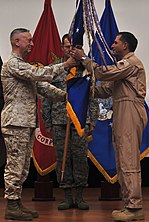
Two major subordinate multi-service commands reporting to Central Command were responsible for Afghanistan: Combined Joint Task Force 180 and Combined Forces Command Afghanistan (CFC-A). CFC-A was disestablished in February 2007.[28] From that point onward, the International Security Assistance Force (ISAF) directed most U.S. forces in Afghanistan. A U.S. general (Dan K. McNeill) assumed command of ISAF that same month.[29]
Temporary task forces include the Central Command Forward – Jordan (CF-J), which was announced in April 2013.[30] CF-J's stated purpose was to work with the Jordanian armed forces to improve the latter's capabilities.[30] There was speculation, however, that another reason for its establishment was to serve as a base from which raids into Syria could be launched to seize Syrian WMD if necessary, and as a launch pad for looming American military action in Syria.[31][32][33]
On 1 October 2008

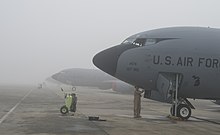
Elements of other
As of 2015[update], CENTCOM forces are deployed primarily in Iraq and Afghanistan in combat roles and have support roles at bases in Kuwait, Bahrain, Qatar, the United Arab Emirates, Oman, and central Asia. CENTCOM forces have also been deployed in Jordan and Saudi Arabia.
War planning
The following war plan numbers have been made public:[35]
- OPLAN 1002-88, addressing Soviet-related armed conflict in the CENTCOM AOR[36]
- OPLAN 1002 (Defense of the Arabian Peninsula).[37]
- CENTCOM OPORDER 01-97, Force Protection
- SOCEUR SUPPLAN 1001-90, 9 May 1989
- CENTCOM CONPLAN 1010, July 2003
- CENTCOM CONPLAN 1015-98, possible support to OPLAN 5027for Korea, 15 March 1991
- CENTCOM 1017, 1999
- CONPLAN 1020
- OPLAN 1021, prior to 1990, referred to "the ..Soviet threat."[38] OPLAN 1021-88 had a nuclear weapons annex, Annex C, that called for the deployment of some nuclear-capable forces. In September 1990, copying deployment lists from the Cold War planning in haste over to Desert Shield deployments after the Iraqi invasion of Kuwait appears to have inadvertently begun the deployment of a MGM-52 Lance short-range ballistic missile unit, 1st Battalion, 12th Field Artillery Regiment. "The unit's equipment was literally on railcars and ready to move to ports in Texas before the missilemen were ordered to stand down."[39]
- CONPLAN 1067, for possible Biological Warfare response
- CENTCOM CONPLAN 1100-95, 31 March 1992
Others listed by Arkin's supplements include CENTCOM CONPLAN 1211-07 "Foreign Humanitarian Assistance / Disaster Response Operations." It was issued in November 2007, and required using the Request for Forces method via then-
Geographic scope
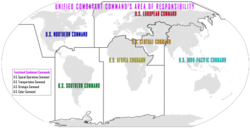
With the 1983 establishment of CENTCOM Egypt, Sudan, Kenya, Ethiopia, Somalia, and Djibouti came within the area of responsibility (AOR). Thus CENTCOM directed the 'Natural Bond' exercises with Sudan, the 'Eastern Wind' exercises with Somalia, and the 'Jade Tiger' exercises with Oman, Somalia, and Sudan. Exercise Jade Tiger involved the 31st Marine Expeditionary Unit with Oman from 29 November 1982 to 8 December 1982.[41]
On 7 February 2007, plans were announced for the creation of a
The Department of Defense uses a variable number of base locations depending on its level of operations. With ongoing warfare in Iraq and Afghanistan in 2003, the
List of commanders

| No. | Commander | Term | Service branch | |||
|---|---|---|---|---|---|---|
| Portrait | Name | Took office | Left office | Term length | ||
| 1 | General Robert Kingston (1928–2007) | 1 January 1983 | 27 November 1985 | 2 years, 330 days |  U.S. Army | |
| 2 | General George B. Crist (born 1931) | 27 November 1985 | 23 November 1988 | 2 years, 362 days |  U.S. Marine Corps | |
| 3 | General Norman Schwarzkopf Jr. (1934–2012) | 23 November 1988 | 9 August 1991 | 2 years, 259 days |  U.S. Army | |
| 4 | General Joseph P. Hoar (1934–2022) | 9 August 1991 | 5 August 1994 | 2 years, 361 days |  U.S. Marine Corps | |
| 5 | General J. H. Binford Peay III (born 1940) | 5 August 1994 | 13 August 1997 | 3 years, 8 days |  U.S. Army | |
| 6 | General Anthony Zinni (born 1943) | 13 August 1997 | 6 July 2000 | 2 years, 328 days |  U.S. Marine Corps | |
| 7 | General Tommy Franks (born 1945) | 6 July 2000 | 7 July 2003 | 3 years, 1 day |  U.S. Army | |
| 8 | General John Abizaid (born 1951) | 7 July 2003 | 16 March 2007 | 3 years, 252 days |  U.S. Army | |
| 9 | Admiral William J. Fallon (born 1944) | 16 March 2007 | 28 March 2008 | 1 year, 12 days |  U.S. Navy | |
| - | Lieutenant General Martin Dempsey (born 1952) Acting | 28 March 2008 | 31 October 2008 | 217 days |  U.S. Army | |
| 10 | General David Petraeus (born 1952) | 31 October 2008 | 30 June 2010 | 1 year, 242 days |  U.S. Army | |
| - | Lieutenant General John R. Allen (born 1953) Acting | 30 June 2010 | 11 August 2010 | 42 days |  U.S. Marine Corps | |
| 11 | General Jim Mattis (born 1950) | 11 August 2010 | 22 March 2013 | 2 years, 223 days |  U.S. Marine Corps | |
| 12 | General Lloyd Austin (born 1953) | 22 March 2013 | 30 March 2016 | 3 years, 8 days |  U.S. Army | |
| 13 | General Joseph Votel (born 1958) | 30 March 2016 | 28 March 2019 | 2 years, 363 days |  U.S. Army | |
| 14 | General Kenneth F. McKenzie Jr. (born 1957) | 28 March 2019 | 1 April 2022 | 3 years, 4 days |  U.S. Marine Corps | |
| 15 | General Michael Kurilla (born 1966) | 1 April 2022 | Incumbent | 2 years, 15 days |  U.S. Army | |
Secretary of Defense
Two of the former U.S. Central Command Commanders would later serve as
Unit decorations
The unit awards depicted below are for Headquarters, U.S. Central Command at MacDill AFB. Award for unit decorations do not apply to any subordinate organization such as the service component commands or any other activities unless the orders specifically address them.
| Award streamer | Award | Dates | Notes |
|---|---|---|---|
| Joint Meritorious Unit Award | 2 August 1990 – 21 April 1991 | Department of the Army General Order (DAGO) 1991-22 & 1992-34[43] | |
| Joint Meritorious Unit Award | 1 August 1992 – 4 May 1993 | DAGO 1994-12 & 1996-01 | |
| Joint Meritorious Unit Award | 8 October 1994 – 16 March 1995 | DAGO 2001–25 | |
| Joint Meritorious Unit Award | 1 September 1996 – 6 January 1997 | Joint Staff Permanent Order (JSPO) J-ISO-0012-97 | |
| Joint Meritorious Unit Award | 1 October 1997 – 15 July 1998 | JSPO J-1SO-0241-98 | |
| Joint Meritorious Unit Award | 16 July 1998 – 1 November 1999 | JSPO J-1SO-0330-99 / DAGO 2001–25 | |
| Joint Meritorious Unit Award | 2 November 1999 – 15 March 2001 | ||
| Joint Meritorious Unit Award | 11 September 2001 – 1 May 2003 | DAGO 2005–09 | |
| Joint Meritorious Unit Award | 2 May 2003 – 31 December 2005 | ||
| Joint Meritorious Unit Award | 1 January 2006 – 1 March 2008 | JSPO J-1SO-0061-08 | |
| Joint Meritorious Unit Award | 2 March 2008 – 1 July 2010 | ||
| Joint Meritorious Unit Award | 2 July 2010 – 31 July 2012 |
See also
References
- ^ "COMMAND NARRATIVE". www.centcom.mil.
- ^ "Commander, General Michael E. Kurilla". U.S. Central Command. Retrieved 30 April 2023.
- ^ "Deputy Commander, Vice Admiral Brad Cooper". U.S. Central Command. Retrieved 13 February 2024.
- ^ "Senior Enlisted Leader, Fleet Master Chief Derrick "Wally" Walters". U.S. Central Command. Retrieved 30 April 2023.
- ^ FM 1-02 Operational Terms and Graphics (PDF). US Army. 21 September 2004. pp. 5–37.
- ^ ADP 1-02 Terms and Military Symbols (PDF). US Army. 14 August 2018. pp. 4–8.
- ^ Andrew Eversden (6 Jan 2022) Biden expected to name 18th Airborne Corps commander to CENTCOM
- ^ "Webcast: CENTCOM Welcomes New Commander". DVIDS. 1 April 2022.
- ^ "Several Senate Armed Services members oppose Austin waiver". Roll Call. 12 January 2021. Retrieved 13 August 2023.
- ^ "AOR | U.S. Army Central". www.usarcent.army.mil.
- ^ a b Cordesman 1998.
- ^ 's novel Sword Point gives an impression of what such planning envisaged and is by a U.S. Army officer who would have had some idea of the general planning approach.
- ^ Swain 1997, p. 6.
- ^ See also https://apps.dtic.mil/sti/citations/AD1145131
- ^ Gordon & Trainor 2012, pp. 6–7.
- ^ Vandiver, John (15 January 2021). "CENTCOM mission expands to include Israel". Stars and Stripes. Retrieved 26 January 2021.
- ^ a b "U.S. Central Command Twitter feed appears hacked by Islamic State sympathizers". Reuters. 12 January 2015. Retrieved 12 January 2015.
- ^ CHRIS GOOD, JOSHUA COHAN and LEE FERRAN (12 January 2015). "Home> International 'Cybervandalism': ISIS Supporters Hijack US Military Social Media Accounts". ABC. ABC news Internet Venture. Retrieved 12 January 2015.
- ^ Cohen, Zachary (1 February 2017). "Report: Centcom leaders didn't cook ISIS intelligence". CNN. Retrieved 10 April 2018.
- ^ McKirdy, Euan (29 January 2018). "US general: US troops won't withdraw from Syrian city of Manbij". CNN.
- ^ Eqbali, Aresu; Rasmussen, Sune Engel (8 April 2019). "Iran Labels U.S. Central Command a Terrorist Organization". The Wall Street Journal. Retrieved 7 January 2020.
- ^ "USARCENT Units".
- ^ "U.S. NAVCENT Home Page".
- ^ "AFCENT Home Page".
- ^ "Marine Corps Forces Central Command". www.marcent.marines.mil.
- ^ Hadley, Greg (2 November 2022). "Space Force to Establish Components for INDOPACOM, CENTCOM, Korea by End of 2022".
- ^ "USCENTCOM > About Us > Component Commands".
- ISBN 9781610695114 – via Google Books.
- ^ Auerswald & Saideman 2014, pp. 96 onwards.
- ^ a b Parrish, Karen (15 August 2013). "Dempsey Visits U.S. Troops Serving in Jordan". American Forces Press Service. Retrieved 5 June 2015.
- ^ Nasser, Nicola (12 September 2013). "Amman's shaky claims to neutrality". Al-Ahram. Retrieved 5 June 2015.
- ^ Shanker, Thom (15 August 2013). "With Eyes on Syria, U.S. Turns Warehouse Into Support Hub for Jordan". The New York Times. Retrieved 5 June 2015.
- ^ McMorris-Santoro, Evan (31 August 2013). "Obama: I Have Decided To Bomb Syria, But I Want Congress To Weigh In First". buzzfeed.com. Retrieved 5 June 2015.
- ^ "Africans Fear Hidden U.S. Agenda in New Approach to Africom". Associated Press. 30 September 2008. Retrieved 30 September 2008.
- ^ Arkin 2005, p. 46.
- ^ Diane T. Putney (2004). Airpower Advantage: Planning the Gulf War Air Campaign 1989–1991 (PDF). pp. 10–11.
- ^ https://williamaarkin.files.wordpress.com/2012/02/arkins-contingency-plans-of-the-us-government.pdf and Arkin, William (1 January 2005). "National Security Contingency Plans of the U.S. Government" (PDF).
{{cite web}}: CS1 maint: date and year (link) - ^ Swain 1997, p. 4.
- ^ William Arkin, "Week Nine: SPECAT Nike Air," Stars and Stripes (newspaper), September 25, 2000.
- ^ Preston, Thomas J. (3 May 2010). "The Smarter Way to Plan for Deployment of Forces for Humanitarian Operations" (PDF).
- ^ Arkin 2005, p. 404.
- ^ Rej, Abhijnan. "US Senate Confirms Lloyd Austin as Secretary of Defense". thediplomat.com. Retrieved 26 January 2021.
- ^ "Department of the Army General Orders". United States Army Publishing Directorate. Archived from the original on 27 April 2011. Retrieved 30 April 2011. (Army Knowledge Online account may be required.)
- Arkin, William (25 January 2005). Code Names: Deciphering U.S. Military Plans, Programs and Operations in the 9/11 World (First ed.). Steerforth. ISBN 1586420836.
- Auerswald, David P.; Saideman, Stephen M. (2014). NATO in Afghanistan: Fighting Together, Fighting Alone. Princeton University Press. ISBN 978-1-4008-4867-6.
- Cordesman, Anthony (August 1998). "USCENTCOM Mission and History" (PDF). Center for Strategic and International Studies. Anthony Cordesman
- Gordon, Michael R.; Trainor, Bernard E. (2012). The Endgame: The Inside Story of the Struggle for Iraq, from George W. Bush to Barack Obama. New York: Pantheon Books. ISBN 978-0-307-37722-7.
- Swain, Richard Moody (1997). Lucky War: Third Army in Desert Storm. U.S. Army Command and General Staff College Press. ISBN 9780788178658 – via Google Books.
External links
- U.S. Central Command official website
- Multi-National Force – Iraq.com mnf-iraq.com (in English)
- Multi-National Force – Iraq shurakaal-iraq.com (in Arabic)
- Spiegel, Peter (5 January 2007). "Naming New Generals A Key Step In Shift On Iraq". Los Angeles Times.
- Foreign Policy, Pentagon Ups the Ante in Syria Fight
- 2-star on Iraq: 'Still a big fight going on here' – Combined Joint Forces Land Component Command – Iraq, 2014
- Joe Biden inches toward war with Iran, makes Israel full military partner - Israel being reallocated to Central Command's area of responsibility






